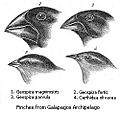Adaptive radiation facts for kids
Adaptive radiation is when a group of living things quickly evolves into many new species. These new species often look different and can live in many different places or ways. It means there's a big increase in the number and variety of species from one original group.
This usually happens when there are lots of empty "jobs" or "roles" in nature, called ecological niches. For example, after a big event like a mass extinction, many habitats might become available with less competition. This allows different groups of animals or plants to spread out and evolve quickly to fill those empty roles.
The idea of adaptive radiation was first talked about by George Gaylord Simpson, a scientist who studied old life forms (a palaeontologist).
Contents
Why do new species appear so fast?
Adaptive radiation happens because of two main reasons: new features evolving, or new opportunities opening up.
New features
Sometimes, a group of animals or plants develops a brand new feature that helps them live in a different way. This new feature can lead to many new species forming.
- The cleidoic egg: A great example is the "cleidoic egg." This special egg developed in early amniotes (like reptiles, birds, and mammals). It has a shell and membranes that protect the baby inside, allowing it to develop on land without drying out. Before this, animals like amphibians had to lay their eggs in water. The cleidoic egg meant that vertebrates could finally move far away from water and live all over the land, leading to many new species.
- Mammal teeth: Another example is how mammals developed a fourth bump (cusp) on their teeth. This small change allowed them to eat many more types of food. Because they could eat different things, they could live in more places, and many new mammal species appeared.
- Flight: When animals evolved the ability to fly, it opened up a whole new world of possibilities!
New opportunities
Adaptive radiations often happen when living things move into new places where there are no other species filling certain roles. This could be a newly formed lake or a group of isolated islands. The animals or plants that arrive can quickly spread out and use all the available resources.
- Lake Victoria fish: In Lake Victoria in Africa, over 300 species of cichlid fish evolved from just one parent species in only 15,000 years! This happened because the lake was new, and there were many empty niches for the fish to fill.

- Hawaiian Islands: The Hawaiian Islands are home to the most diverse group of fruit flies in the world, with about 800 known species. Scientists believe all these flies came from a single ancestor species that arrived on the islands about 20 million years ago. Because there was little competition and many empty niches, the flies evolved into many different forms.
- After mass extinctions: Adaptive radiations often happen after mass extinctions. When many species die out, it leaves a lot of empty niches. For example, after the non-avian dinosaurs died out at the end of the Cretaceous period, mammals quickly evolved and spread out to fill many of the roles the dinosaurs used to have.
Big examples of adaptive radiation
- The Cambrian explosion: This is the most famous example. Most major animal groups (called phyla) appeared very quickly during or just before the Cambrian period.
- Flight: All animals that can fly have been very successful.
- The Upper Triassic radiation of dinosaurs: Dinosaurs spread out and diversified rapidly after a big extinction event.
- The Upper Cretaceous radiation of flowering plants: Flowering plants also evolved and spread widely, changing Earth's landscapes.
Related pages
Images for kids
-
Four of the 14 finch species found in the Galápagos Archipelago, which are thought to have evolved via an adaptive radiation that diversified their beak shapes, enabling them to exploit different food sources.
See also
 In Spanish: Radiación adaptativa para niños
In Spanish: Radiación adaptativa para niños




